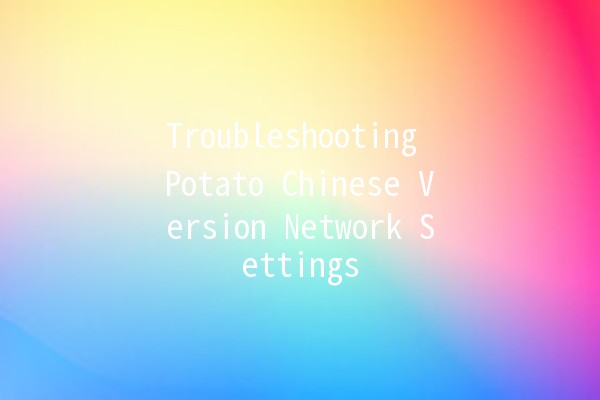In the fastevolving world of digital connectivity, setting up your network can often feel like finding your way through a maze. With devices like Potato (the Chinese version of a popular networking solution), users can experience several challenges. These can range from configuration errors to connectivity issues. In this article, we’ll explore practical solutions to common network settings problems associated with the Potato Chinese version, while providing useful tips to improve your productivity.
Understanding the Potato Chinese Version
The Potato Chinese version is known for its userfriendly interface, aimed at simplifying the configuration of network settings for a seamless experience. Whether you're connecting to WiFi, setting up a VPN, or managing your network settings, understanding the basics is crucial. Below are five productivityenhancing tips to help you navigate the network setup process effectively.
Explanation:

Before making any configurations, ensure that your Potato device is compatible with your existing hardware and software. Check for updated versions of the firmware and compatibility with your router.
Implementation:
For example, if you are using an older router, you might encounter connection issues with the latest version of Potato. To solve this, check the manufacturer's website for updates or consider upgrading your router. Regularly checking for compatibility can save you time and frustration during setup.
Explanation:
WiFi settings play a crucial role in maintaining a reliable connection. Adjusting settings like channel selection and bandwidth can significantly improve performance.
Implementation:
You can use tools like WiFi Analyzer apps to check the channel usage in your area. If multiple networks are using the same channel, switch to a less congested one. Additionally, ensure that you are using the 5GHz band if your device supports it, as this band typically offers higher speeds and less interference than the 2.4GHz band.
Explanation:
Using a VPN can enhance security while browsing. Potato allows users to set up a VPN connection directly through its interface.
Implementation:
To configure a VPN on your Potato device, navigate to the VPN settings in the network configuration menu. Input the necessary details provided by your VPN provider. This setup ensures that your browsing activity remains private and secure from threats, especially on public networks.
Explanation:
Keeping your network hardware updated can resolve existing bugs and improve stability. This is crucial for maintaining optimal performance.
Implementation:
Check the Potato device settings for firmware updates. If an update is available, follow the onscreen instructions to install it. Many users overlook this step, yet it can lead to improved functionality and connectivity issues being resolved.
Explanation:
QoS settings allow you to prioritize certain types of network traffic, ensuring that important tasks receive the bandwidth they require.
Implementation:
If you often stream videos or play online games, accessing the QoS settings on your Potato device can help. Configure your Potato device to prioritize streaming services or gaming traffic. This setup can minimize lag during critical moments, enhancing your experience.
Common Troubleshooting Questions
To reset your Potato device, locate the reset button, typically found on the back of the device. Press and hold the button for about 1015 seconds until the lights on the device blink. This action will restore the device to its factory settings, erasing any custom configurations.
First, ensure that your WiFi is enabled on the Potato device. Check that you are within range of the router and that the signal is strong. If issues persist, restart both the router and the Potato device. If this doesn't work, consider checking the router settings or contacting your ISP.
Slow internet speeds can result from various factors, including network congestion, outdated firmware, or incorrect settings. Check for interference from other devices, and ensure that your Potato device firmware is up to date. Adjusting QoS settings may help prioritize bandwidth for important applications.
To enhance security, change the default password to a strong, unique one. Enable WPA3 encryption if supported, and ensure that remote access is disabled unless needed. Regularly monitor connected devices to detect any unauthorized access.
Yes, you can set up multiple Potato devices on the same network. Just ensure that each device has a unique IP address. This setup can be particularly useful in larger spaces where additional coverage may be required.
Intermittent connectivity can be caused by interference, hardware issues, or incorrect settings. Check for physical obstructions between your Potato device and the router. Additionally, consider changing the WiFi channel or frequency band to reduce interference from neighboring networks.
By following these insightful tips and troubleshooting common issues, users can successfully navigate network settings for the Potato Chinese version. Whether you aim to enhance your internet experience or secure your network settings, a proactive approach can lead to a more efficient and enjoyable use of your Potato device.